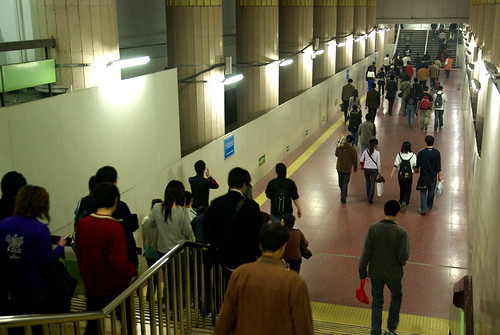BEIJING, CHINA — One of the bizarre things with the Beijing Subway‘s interchange stations, like Xizhimen (西直门) in the northwest of central Beijing, is that you need to walk an incredible distance between the stations on both connected lines. Xizhimen is the station that connects Beijing’s original circular line, Line 2, or the Blue Line, with its new Line 13, or the Yellow Line, which is a city rail line that takes more than an hour to semicircle to Dongzhimen (东直门), its terminus near the East corner of Line 2 (also future hub for the Airport Express to be inaugurated in June 2008). This previous photo shows the station at rush hour, on a Thursday evening at around 5:30 PM.
The Line 13 and Line 2 stations of Xizhimen are actually separate stations. From the newer (inaugurated 2002-03) Line 13 station, you have to walk a good 10 minutes to get to the Line 2 station. below a shopping mall, outside through path like you find at amusement parks). If it’s rush hour, they would also make you walk outside, across the Xizhimen interchange/overpass to get to the subway stop’s opposite eastern exit.
If you don’t have to walk across the overpass, like I did on Wednesday, you then go through tunnels that seem to belong to an old or undeveloped interchange station. These are a little eerie, and may’ve been useful in case of a nuclear war. In fact, whereas the new subway lines make you feel like if you were in Hong Kong, the old ones (especially Line 2) definitely make you feel like if you were back in the Cold War era.
This article was originally published in Comme les Chinois.



3 comments
Tokyo is like this too, since the many (!!!! – http://www.bento.com/subtop5.html) lines are privately owned and developed opportunistically, sometimes you have to walk a good km to get from one line to another. Mastering efficient routes must take a lot of trial and error.
… and from what I can see, zero graffiti.
I recently saw a photo display on the Moscow metro system and there seened to be no spraypainted crap there, either.
Whereas here, the nice new platform at Henri Bourassa, with the lighting plan by Axel Morgenthaler, has ALREADY been ruined.
davidm: Yes, but in Beijing it is publicly-owned! (But developed by Hong Kong’s MTR Corporation, which explains the similarities…) In fact, these convoluted interchange stations remain a mystery, and would be very curious to know about the real reasons besides lack of underground space, or lack of planning way ahead.
Shawn: Yes, you are totally right for the graffiti. Beijing is a city that has zero graffiti. The only place I’ve seen graffiti was at the 798 art district (it stroke me right away when I saw them), perhaps in a controlled/sanctioned manner. I don’t know if it’s a lack of graffiti culture in China, severe punishment, or just a mix of both.